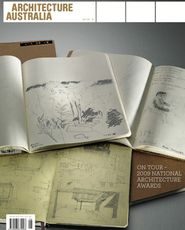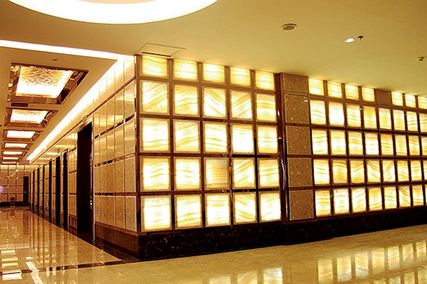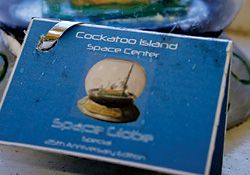
Detail of Geoff Manaugh’s tarot deck, which formed the brief for a narrative-based speculative project for the students.
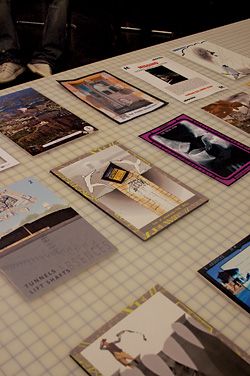
A selection of the work produced by Geoff Manaugh’s studio.
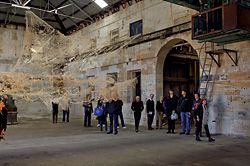
An installation produced by Mette Ramsgard Thomsen’s studio. It was composed of two sheets of fabric net that were sewn with conductive thread so that when each surface touched, a circuit was formed, driving the motor, tightening the fabric so that more strands would tear.
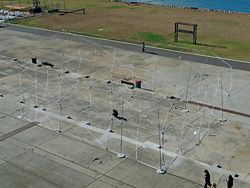
“The Draw”, a giant mapping of one of the site’s demolished buildings, produced in Mark Smout’s studio.
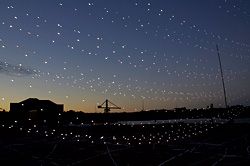
“The Deep Space”, built from reflective bicycle fabric on fishing wire as part of Mark Smout’s studio. Photography Jordan Gillman.
Marcus Trimble revisits Cockatoo Island for this year’s Urban Islands studio.
My father worked at Cockatoo Island when I was young. At the time, it seemed as legitimate a workplace as any other; for all I knew everyone’s dad worked on an island. And while memories of open days on the island, touring battleships and submarines and the like are strong, the lasting impression is of waiting at Woolwich Wharf for the ferry to arrive packed with machinists, draftsmen, engineers in the afternoon. As the ferry approached, the deckhand readying the heavy rope that would tether boat to wharf, the workers would leap over the sides of the boat over the water and onto the wharf in a show of bravado that, in the mind of an eight-year-old, was the coolest show of bravado ever. It was clear, from their lack of respect for the authority embodied in the deckhand, that this was a place where maybe you didn’t look to the right, look to the left, look to the right again before you walked straight across the road.
Today, if you jumped off the side of a moving ferry onto the wharf you would be arrested, but Cockatoo Island still retains a sense of lawlessness, its convict and military history still a strong presence among the daytrippers, art tourists and campers. The Urban Islands studio, now in its third iteration, taps into this landscape easily, delighting in propositions that obstruct.
Organized by Olivia Hyde, Joanne Jakovich and Tom Rivard, the studio involves students from all local universities as well as several national and international students. Each year three tutors are invited from abroad to take the two-week intensive studio, which culminates with presentations on site in front of a number of invited critics.
This year, the invited guests were Mark Smout, of the Bartlett School of Architecture and the practice Smout Allen; Geoff Manaugh of BLDGBLOG, the blog and the book; and Mette Ramsgard Thomsen from CITA in Denmark.
The review day started with Geoff Manaugh’s studio, at the bend in the Dogleg Tunnel, a subterranean space carved from one side of the island to the other. Manaugh’s studio comprised two exercises, the first being an analysis of the island through the mechanism of the tarot deck. The tarot was not used for any occult purposes, rather as a structural system, dividing the island into four suits – processes, routes, materials, absences – and major arcana. The resulting cards hung in the tunnel, a series of studies unfettered by the typical site mapping strategies of architecture studios.
Students were dealt a hand of these cards, which formed the brief for a narrative-based speculative project. Presented rapidly by the sixteen students, the accumulation of these projects formed a collection of paraphernalia from an alternate Cockatoo Island, something like a steampunk island of alternate sciences. We were shown a microbrewery serving bespoke light samples captured at various points on the island, presented as four vials of glowing coloured liquid; a detailed board game of missing buildings; a zombie apocalypse comic book; the re-imagining of the island as zeppelin landing ground presented as collectable trading cards concealed in packets of chips and cereal complete with silver foil packaging (genius …); the Museum of Acoustic Geology, where various environments are brought to the island so their acoustic qualities can be preserved, presented by a tour guide; warships appear from nowhere in city streets; machinery schematics; platforms for plane spotters; counterfeit archeological histories in top secret yellow envelopes; you get the idea.
The “souvenir” tarot appeared to have been dealt out to many of the students, prompting a lengthy discussion on commerce and commodity, and radical interventions asking what action should be taken on the island, or if it should be preserved and sanitized.
Mette Ramsgard Thomsen’s studio prepared four fabric installations, one in the Dogleg Tunnel adjacent to the tarot cards, the other three in spaces off the turbine hall. These installations examined the potential of fabric as a performative surface, the most interesting of which was made of two sheets of fabric sewn with conductive wire hung in space from fishing wire connected to small servo motors. The fabric nets were sewn with conductive thread so that when strands from each surface touched, a circuit was formed, driving the motor, tightening the wire, prompting more strands to tear, the whole thing slowly ripping itself apart. The installation faced a few technical difficulties on the day, with some manual override required, but the promise of a self-destroying canopy proved captivating nonetheless.
Finally, Mark Smout’s studio tackled the external spaces of the island, with a series of constructions on the apron facing the turbine hall. Named “Ballistic Instruments”, they each constructed ways of seeing the island in specific ways. “Rovers” are portable instruments that scan their environment; “The Draw” is a giant mapping of one of the site’s demolished buildings sketched over the apron, its perspective coalescing when seen from the observation deck above, and its points held in place by concrete weights cast from swimming caps. “The Heralds” are devices that “amplify the elemental qualities of the site”. I particularly like “The Deep Space”, the space between the hull of a boat and the walls of the dock, built from reflective bicycle fabric on fishing wire, the dimensional form of which is made visible when captured by flash photography. The idea that capturing an image is simultaneously the act of exposing and creating form neatly meshed with Smout’s interest in photography and landscape.
Cockatoo Island is by now firmly embedded in Sydney’s consciousness as its pre-eminent playground for cultural activity, an awareness that took root with the Cockatoo Island Festival in 2005 and was consolidated by 2008’s Sydney Biennale and this year’s Nick-Cave-curated All Tomorrow’s Parties – incidentally, the politest rock festival I have witnessed. Surrounding this reawakening, the Urban Islands studio provides a platform for a critical engagement with the island beyond its now accepted role as arts venue and post-industrial relic, an essential activity if it is to remain a site of fantasy and lawlessness.
Marcus Trimble is a director of Super Colossal.

